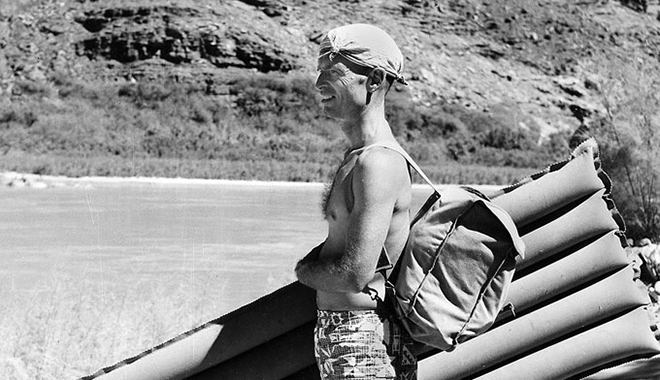Most hikers today won’t set foot in the Grand Canyon without first researching their trips online, downloading GPS coordinates, and maybe buying a satellite beacon. Ignoring the technology would mean confronting the unknown, a frightening prospect when talking about a mile-deep abyss. Yet this was the very reason John Harvey Butchart became obsessed with unraveling the Canyon’s depths.
Its vast interior remained largely unexplored in modern times. In 1945 Butchart was a 38-year-old husband, father, and mathematics professor when he took his first hike down the Bright Angel Trail. By 1983, when old age forced an end to his trekking, Butchart had become the most accomplished explorer the canyon had ever seen.
“It was like he was made out of piano wire,” said a friend of Butchart’s.
Indeed, the wiry 135-pounder could move so fast and tirelessly through the gorge that younger men would sometimes vomit trying to keep up.
Numbers held great importance with Butchart the mathematician. He religiously documented his trips, thus we know his list of feats. He spent nearly three years’ worth of days beneath the rim, averaging 12 miles per day (much of it off-trail) to total more than 12,000 miles. In 1963 he became the first to hike the length of the national park (as it stood in 1963, though not in one continuous hike). He made 28 first ascents – most by anyone – on his way to climbing 83 inner-canyon summits.
Butchart was also fond of discovering new routes from the rim to the Colorado River, and he nabbed more than 100 of them, many of which had seen more traffic during the Ancestral Puebloan era of the 1200s than in the 20th century. Butchart also wrote the first guidebooks to the canyon’s backcountry, which were titled Grand Canyon Treks.
SEEDS PLANTED IN CHINA
Born in 1907 in Nanchang, China to Christian missionary parents, Butchart spent his early days hiking and exploring nearby Mt. Lushan National Park. The mountain’s mesmerizing beauty had also attracted the likes of Chinese poet Li Po and novelist Pearl Buck.
Butchart’s parents had a summer cottage there that lay at the end of a long hike: an 8-mile, 3,000-foot ascent from the Yangtze River.
In 1917, after Butchart’s father died of a gangrenous infection, his mother Nellie moved the family to Illinois where relatives could help care for them. Butchart stayed in the Midwest for over 20 years, earning a doctorate in math at the University of Illinois, marrying, struggling through the Depression, and then working as a math professor at several universities.
In 1945, his daughter was diagnosed with asthma and the doctor advised moving to a dry climate. Butchart relocated his family to Flagstaff, Arizona, where he took a teaching job at Northern Arizona University. After so many years in the flatlands, Butchart’s pent-up desire to ramble on foot now had an outlet in the Southwest.
After just a few hikes at Grand Canyon, Butchart had found his life’s purpose. So little was known about the gorge’s interior that neither the park rangers nor anyone else could tell him what lay beyond the few trails. He quickly realized that here was an opportunity to etch his name upon a blank spot on the map.
UNDAMPENED BY MISHAPS
With little time to waste, Butchart adopted a light and fast approach to hiking the canyon. He also favored the cheapest possible equipment, such as Kmart boots, a tarp instead of a tent, and an inflatable air mattress for a sleeping pad. The air mattress served dual duty as a means to float the Colorado River to allow access to remote side canyons. This backfired in 1955, however, when his best friend drowned while they both rode air mattresses on the flooding Colorado.
Other misfortunes would follow. He broke both heels jumping over a creek, broke a rib while arresting a fall, and nearly died after rolling a boulder onto himself. Yet none of it could dampen his desire to become the authority on Grand Canyon’s backcountry, and his pace of exploration accelerated with each passing decade.
Along with publishing guidebooks, Butchart ensured that his treks would benefit future canyoneers by also writing detailed logbooks. More than a thousand pages of typed trip logs document his every move in the canyon. Today these form the most expansive resource available for deciphering possible routes in remote areas of the park.
After his death in 2002 due to natural causes, Butchart was given a rare honor. In 2009 the U.S. Board of Names bestowed the title “Butchart Butte” upon a prominent 7,600-foot sandstone spire in Grand Canyon National Park to commemorate his accomplishments. Appropriately, the butte isn’t trail-accessible.
Elias Butler, along with Tom Myers, is the author of Grand Obsession: Harvey Butchart and the Exploration of Grand Canyon, which is out of print but can be found used at Amazon. Photo by Dale Slocum.

